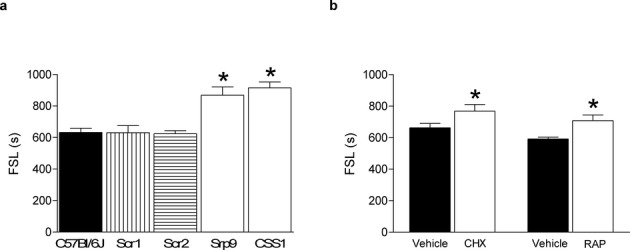Figure 2.

Downregulation of Srp9 mRNA in C57BL/6J in vivo reduces FS susceptibility. (A) ICV injection of Srp9 antisense oligonucleotide (AS Srp9) probe in C57BL/6J pups 20 h prior to hyperthermia significantly (F2,31=10.554, P = 0.0003) prolonged FSL (sec) in C57BL/6J (n = 12; 869.0 ± 52.3 sec) mice compared to scrambled (Scr) probe injected littermate controls (Scr-1, n = 12; 630.2 ± 45.4 sec, P = 0.001), and (Scr-2, n = 10; 624.5 ± 52.3 sec, P = 0.001). This in vivo treatment resulted in downregulation of Srp9 transcript levels (−15%; P < 0.04) in the cortex compared to controls. (B) IP injection of cycloheximide (CHX, n = 9; 769.1 ± 41.1 sec) 20 min prior to hyperthermia delayed FSL (t16 = −2.141, P = 0.048) compared to vehicle controls (n = 9; 662.6 ± 28.0 sec). IP injection of rapamycin (RAP, n = 9; 708.1 ± 35.9 sec) 30 min prior to hyperthermia delayed FSL (t16 = −2.700, P = 0.018) compared to controls (n = 9; 591.9 ± 11.4 sec). Error bar indicates SEM; *P < 0.05. ICV and IP injections did not affect temperature curves during hyperthermia induction (data not shown).
